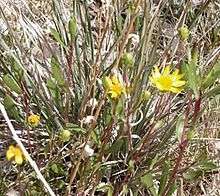Grindelia fraxinipratensis
| Grindelia fraxinipratensis | |
|---|---|
 | |
| Scientific classification | |
| Kingdom: | Plantae |
| (unranked): | Angiosperms |
| (unranked): | Eudicots |
| (unranked): | Asterids |
| Order: | Asterales |
| Family: | Asteraceae |
| Tribe: | Astereae |
| Genus: | Grindelia |
| Species: | G. fraxinipratensis |
| Binomial name | |
| Grindelia fraxinipratensis Reveal & Beatley 1972 | |
| Synonyms[1] | |
| |
Grindelia fraxinipratensis, Ash Meadows gumweed,[2] is a North American species of flowering plants in the daisy family. It is native to the southwestern United States, in Mojave Desert regions in Nye County in Nevada and Inyo County in California. Some of the Nevada populations (including the type locality) lie inside the Nevada Test Site of the United States Atomic Energy Commission[3][4]
Some sources spell the name as G. fraxino-pratensis. Grindelia fraxinipratensis is the accepted spelling according to the International Code of Nomenclature.[5]
Grindelia fraxinipratensis grows in meadows and on the borders of woodlands. It is a biennial or perennial herb growing 50–120 cm (19.5–47 in) tall, erect in form, brown or reddish, and hairless and oily. It grows from a thick undergroung caudex atop a woody taproot. The dark green leaves are up to 7 centimeters (2.8 inches) long, widely lance-shaped or oblong, sometimes toothed near the tips, and studded with visible resin glands. The inflorescence bears one to four flower heads lined with thick phyllaries. The head contains about 15 yellow disc florets surrounded by about 13 yellow ray florets each about 4 millimeters (0.16 inches) long. The fruit is an achene with a pappus made up of two awns.[6]
Grindelia fraxinipratensis is native to the Amargosa Valley along the southern part of the border between California and Nevada, where it is known from only 14 to 16 locations.[7] Many are found within the Ash Meadows National Wildlife Refuge in the Amargosa Desert area.
The plant grows in the clay, saline and alkaline soils of the land surrounding desert warm springs in the valley. Its main habitat type is the saltgrass meadow (Distichlis spicata). It is relatively abundant in the moist areas of its habitat, and rare in the drier areas.[8]
Grindelia fraxinipratensisis a federally listed threatened species. Habitat in the area was first altered when peat mining was started and Carson Slough, a large local wetland, was drained.[9] The area was then farmed. Large scale farming by corporate agriculture altered much of the Ash Meadows habitat. Today a main threat to the species is the lowering of the water table, which may move water supplies too deep into the soil for the plant to reach with its roots.[8][9] Other threats include trampling by feral horses and cattle, off-road vehicle use, and non-native plant species.[10]
References
- ↑ Tropicos, Grindelia fraxinipratensis Reveal & Beatley
- ↑ "Grindelia fraxinopratensis". Natural Resources Conservation Service PLANTS Database. USDA. Retrieved 18 July 2015.
- ↑ Biota of North America Program 2014 county distribution map
- ↑ photo of herbarium specimen at Missouri Botanical Garden, collected in Nevada in 1968, isotype of Grindelia fraxinipratensis
- ↑ International Code of Nomenclature for algae, fungi, and plants (Melbourne Code) articles 60.8 and 60.9
- ↑ Flora of North America, Grindelia fraxinipratensis Reveal & Beatley, 1972.
- ↑ Nevada Natural Heritage Program
- 1 2 SDSU Soil Ecology & Research Group. (2004) Demographics and Ecology of the Amargosa Niterwort (Nitrophila mohavensis) and Ash Meadows Gumplant (Grendelia fraxino-pratensis) of the Carson Slough Area
- 1 2 FWS. (1985). Determination of threatened status with critical habitat of six plants and one insect in Ash Meadows, Nevada and California... Federal Register.
- ↑ Hasselquist, N. J. and M. F. Allen. (2009). Increasing demands on limited water resources: Consequences for two endangered plants in Amargosa Valley, USA. Am J Bot 96: 620-626.